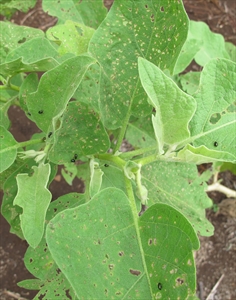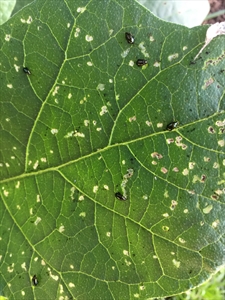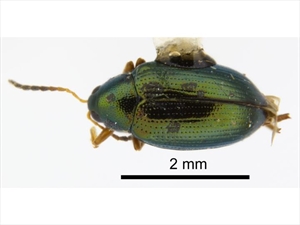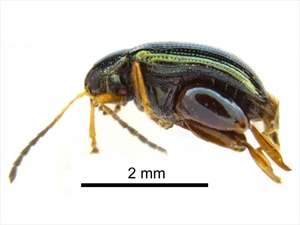Eggplant flea beetle, Psylliodes flea beetle
Pacific Pests, Pathogens and Weeds - Online edition
Pacific Pests, Pathogens & Weeds
Eggplant flea beetle (247)
Psylliodes species. The beetle is recorded from Fiji and Tonga as Psylliodes brettinghami, but other species are likely to be present in the Pacific islands. However, even though the different species may have different hosts, it is likely that they have similar life cycles. Psylliodes brettinghami is thought to be synonymous with Psylliodes cucurbitae.
Asia, Africa, North and Central America, Europe, Oceania. It is recorded from Australia (Lord Howe Island), Fiji, Tonga, and Vanuatu.
Psylliodes species infest a number of solanaceous crops, including eggplant, potato, tomato, and weeds, such as black nightshade (Solanum nigrum), jimsonweed (Datura stramonium), and gooseberry (Physalis angulata).
The adults make clusters of small irregular holes in leaves as they feed (Photos 1-3), giving the impression of damage from fine bore shot [like, for instance, the bele (Abelmoschus) flea beetle (see Fact Sheet no. 22)]. Damage to seedlings may destroy the crop. Symptoms are similar on tomato (Photo 4).
The life cycle of the Pacific species is unknown. The following information is from other parts of the world. Eggs are yellowish, minute and laid singly or in clusters in soil beside the plant stems. Each female lays up to 500 eggs. Eggs probably hatch at about 7 days. The larvae, which have pale yellowish-white with brown heads, tunnel through stems, roots or leaf midribs. They have three stages and become mature in about a month. Afterwards, they pupate in small chambers constructed in soil beside the plant, at 0.5-8 cm depth. Pupation lasts up to a month. The adults are 3-4.5 mm long, shining brassy-green, green, or blackish blue with metallic shine, with lines of small pits on the wing covers (Photos 5&6). They have enlarged thigh on their hind legs and can jump considerable distances and also fly.
The flea beetle causes impact in two ways: (i) directly, as adults eating the leaves and affecting fruit yield, and (ii) indirectly, by transmitting plant viruses. Also, larvae add to the direct damage by burrowing inside roots, stems or midribs of leaves, and reduce plant vigour.
Look for numerous small holes in leaves made as the adult flea beetles feed. Look for adults on the underside of leaves, but they are easily disturbed, so turn leaf over slowly or bend down to look from underneath. It is very unlikely that the larvae can easily be found in the soil. They are very small.
QUARANTINE
Psylliodes species are probably native to the west Pacific region, feeding on indigenous Solanum species. However, there are probably several species and until their distributions are better known, efforts should be made to prevent spread between countries.
CULTURAL CONTROL
Before planting::
- Avoid overlapping crops of eggplant (tomato, potato), especially planting new crops next to old where the beetle is present.
- Leave at least 3 month between crops.
During growth
- Use fertilizer or composts to accelerate seedling development, otherwise attack by the flea beetle may stunt seedling growth.
- Remove weeds from within and around the plots; especially remove any weeds related to eggplants, i.e., wild Solanum species.
After harvest:
- Collect and burn or bury as much of the crop as possible.
CHEMICAL CONTROL
Spraying may be necessary when adults are in high number.
- Use plant-derived products, such as derris, pyrethrum or chilli (with the addition of soap).
- Note, a variety of Derris, brought many years ago to Solomon Islands from Papua New Guinea, is effective as a spray. It contains rotenone, an insecticide, so it should be used with caution. There may be varieties of Derris (fish poisons) in your country that can be tried (see Fact Sheet no. 56).
- Alternatively, use synthetic pyrethroids; they are likely to be effective, but will also kill natural enemies.
____________________
When using a pesticide, always wear protective clothing and follow the instructions on the product label, such as dosage, timing of application, and pre-harvest interval. Recommendations will vary with the crop and system of cultivation. Expert advice on the most appropriate pesticide to use should always be sought from local agricultural authorities.
AUTHORS Grahame Jackson & Mani Mua
Information and from (including Photos 5&6) Henderson RC, Crosby TK (2012) Flea Beetle (Psylliodes brettinghami): PaDIL - (http://www.padil.gov.au).
Produced with support from the Australian Centre for International Agricultural Research under project PC/2010/090: Strengthening integrated crop management research in the Pacific Islands in support of sustainable intensification of high-value crop production, implemented by the University of Queensland and the Secretariat of the Pacific Community.









